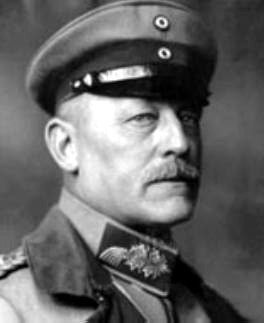Oskar von Hutier
After the Czar’s abdication in March, the Russian state and the army continued to disintegrate. A Provisional Government was formed but its authority was contested by the Council of Workers and Soldiers Deputies (the Soviet), which insisted that military planning should be approved by soldiers’ committees. Oblivious to the political consequences, the French insisted on some kind of Russian offensive in 1917 and a chaotic process of operational planning began. German operations against the Stokhod bridgehead demonstrated Russian fragility but the Central Committee continued to assure its allies that they would honour their commitment to continue fighting. Kerensky, the charismatic War Minister, began planning a grand offensive. The two-day bombardment was one of the most impressive of the war but the assault collapsed as reserve units refused to support the initial successful advances or proved brittle under fire. Kerensky seized power from the Provisional Government and authorised further offensives but only the Romanians proved capable of fighting effectively, winning a bruising fight at Ma¡ra¡sti in July, where they deployed their artillery under French tuition.
The German Eighth Army, commanded by Oskar von Hutier, was tasked in August 1917 with finally breaking through Kornilov’s Russian Twelfth Army at Riga. Plans had been under consideration since April, but the Russian positions were formidable and the garrison well prepared. Kornilov seems to have been aware that the offensive was imminent but appears to have played little role in the battle except authorising the retreat. Fresh divisions were assigned to Hutier’s command but more importantly he planned to use a combination of the latest assault tactics to achieve a decisive breakthrough, with a fire-plan orchestrated by Colonel Bruch-müller. The infantry assault units were trained in infiltration methods – an approach initially suggested by Laffargue but perfected by Hauptmann Willy Rohr and others – on a grand scale for the first time. The Germans intended to use abbreviated registration in the first phase of the preparatory bombardment to mask the detailed fire-plan. This simple system was an effective solution to the problem of maintaining surprise. Instead of a long general bombardment or a slow methodical battering of key positions over several days, abbreviated registration required the batteries supporting the main assault to use pre-set registration points to first confirm their position on the battlefield and then shift their fire to targets identified within the carefully surveyed area around their initial registration point. Batteries could thus arrive during the night, pre-register at dawn, then fire on their main targets with a reasonable chance of hitting the target. Accuracy was worse than the old way but chemical rounds meant near-misses could still neutralise targets. Allied analysts would ultimately conclude the Germans had discovered a new way of delivering unobserved fire without registration.
Mindful of the damage the Russian artillery could cause during the Duna River crossing, the first two hours of the fire-plan, planned for 1 September, also included a hurricane bombardment against identified battery positions. To ensure counter-battery success, the artillery was reinforced from both the Eastern and Western Fronts, with enough ammunition to provide a genuine test of Bruchmüller’s methods. Given the scale of the bombardment, it is perhaps unsurprising that the Russians failed to notice the final phase of the abbreviated registration plan during the torrent of shellfire. The mix of shells (three-quarters gas and one-quarter high explosive) shattered the communication system and silenced most of the batteries. After 2 hours the majority of the heavies continued to focus on the Russian batteries while the rest, including the trench mortars, adjusted their sights according to the data gathered from the abbreviated registration phase and began to pound the front lines with a mix of shells dominated by high explosive (80:20). After another 3 hours of intense fire, the remaining heavy batteries joined the main barrage for a final terrifying few minutes before the creeping barrage commenced, leaving only one gun per battery to maintain the lethal miasma over the Russian gun positions.
The creeping barrage surged forwards after 5 hours and 10 minutes of pounding. As Zabecki notes in his biography of Bruchmüller, the main barrage had delivered 10, 500 tons of high explosive on to the Russian defensive system – the equivalent of 500 B-52 bomber payloads. The devastation was made more horrific by the densest utilisation of gas shells since the technology was introduced and by the relative accuracy of the fire. Unlike the timed barrages at Verdun, the six lifts in the German creeping barrage were coordinated by the advancing infantry firing green flares. Bruchmüller’s fire-plan fed additional silent batteries in to each phase while earmarked batteries pounded identified targets in the rear areas, sowing further chaos. Once the river crossing was complete (aided on the day by the morning mist), the heavy guns switched back to counter-battery fire. Light guns were rafted over for the attack on the second position, at which point the heavy guns switched targets to give supporting fire. The next phase of the fireplan supported the consolidation units building the bridges, covered the movement of heavy guns over the river and assisted the assault units by disrupting counter-attacks on the bridgehead. Once these were in position the final phase of the fire-plan could begin and the exploitation phase could theoretically commence before the Russians could move any effective reserves into play. The only aspect missing in the plan was the recognition that confusion was inevitable as soon as the assault units surged over the bridges and into the chaos created by the Russian retreat. This elaborate fire-plan confirmed Bruchmüller’s reputation as a master gunner and his version of the creeping barrage was quickly nicknamed the `feuerwalze’, a peculiarly light-hearted term which nevertheless captures his skilful orchestration of phased zone fire missions. While the intended effect is always entirely destructive, the creation of a complex fire-plan certainly shares some of the combination of art and precision that characterises musical composition.
